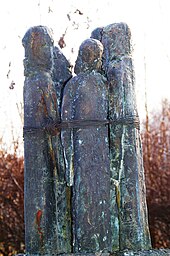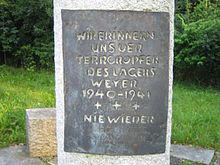Degeneration of the heart
Herzfleischentartung is a novel by Ludwig Laher from 2001 in which the author portrays the Austrian province from 1940 to 1955.
content
In the southwest of the Upper Austrian Innviertel , then Oberdonau who wants NSDAP drain the Ibm Moor. 250 new farms are to be built on the site. Forced laborers have to regulate the Moosach under the most difficult conditions . The labor education camp specially set up for this purpose is mainly fed by mayors who, often for private reasons, want to get rid of unwelcome fellow citizens. At the turn of 1940/1941 the camp doctor no longer wanted to confirm false harmless causes of death when the guards brutally murder inmates. His complaint prompted a courageous senior public prosecutor to investigate in the middle of the Third Reich , to take camp managers and supervisors into custody, to work fifteen months towards a process that would also bring the desk perpetrators to account. Massively threatened by the NSDAP in Linz , Josef Neuwirth does not allow himself to be stopped until the Reich Chancellery finally decrees that the proceedings are put down. Immediately after the camp doctor reported, the Gau-NSDAP closed the terrorist site and reopened it as a gypsy detention camp ten days later . Hundreds of autochthonous mostly Upper Austrian Sinti and some Roma , including around 250 children and young people, are now interned there. Who does not already Weyer- St.Pantaleon dies, is in November 1941 after Poland deported and murdered. The last third of the novel shows how in post-war Austria the old Nazi elites in the village quickly made a career with the new major parties ÖVP and SPÖ , the perpetrators in the Second Republic were mostly sentenced to low sentences and those who were racially persecuted were again marginalized. The book ends with the great amnesty given by the Federal President in 1955, which set almost all Nazi criminals free. About the ending he chose, Laher said in 2004: “My novel“ Herzfleischentartung ”does not stop there, because the victims are dead in a comprehensive sense only when the perpetrators have achieved their ultimate goal, namely to destroy memories and the victims thus to be eliminated from history. My text does not end in 1945 either, because the so-called zero hour is by no means the turning point that radically breaks with racist barbarism ”.
shape
The novel's great success is probably due at least as much to the language Ludwig Laher has chosen for his text as to the content it conveys. For a long time, Laher aggressively uses the fast-paced, utilitarian , cynical , elbow-ridden language of the National Socialists, which leaves little room for empathy and immediately sweeps the reading audience away again where speed is slowed down and an individual's fate is briefly picked out: the structures of barbarism solve them acting characters as "heroes".
review
"Precisely because it adheres to the concrete facts of a regionally limited case, which, however, retain the general validity inherent in literature through the design, this book succeeds in making a statement about the nature of National Socialism and its tough survival that has seldom been presented so clearly and convincingly was. ”So Anna Mitgutsch in her review of“ Herzfleischentartung ”for the standard . Ulrich Weinzierl praised the author in Die Welt : “Ludwig Laher dared to do extremely tricky things. In his new book “Herzfleischentartung” he explores the suppressed history of the St. Pantaleon Nazi camp in his Upper Austrian homeland. The factual narrator is superior to any historian because he knows how to productively use the cynicism of Nazi jargon and the clichés in his chronicle ”.
“In addition to the author's in-depth, meticulous historical knowledge, what is most impressive about this book is the language. Dynamic and with numerous breaks, the reader not only receives insights into historical processes but also into a possible world of thought of the perpetrators. And that's exactly what impressed me about this book. As a reader you have to be constantly on the lookout for this writer. He takes you by the hand and leads you to places and events to which you would never have exposed yourself. With a seemingly light, witty and sometimes even witty language, he seduces the user to let go of the emotional cover that has been put in place for such literature, and in this way he creates bewilderment and dismay even in people who think they are hardened. A book that I found difficult to read, but which I wouldn't want to miss for a moment. "
The book met with great approval from critics almost across the board in the countries where it was published. In Austria it is now widely used as school reading.
reception
In the course of the author's research on the book, the Weyer / Innviertel Memorial Site was also established in his sphere of activity, which maintains the memorial site, offers tours and organizes the annual commemoration ceremony. Laher himself, who is very committed to a comprehensive quality of school education in Austria, holds numerous readings and lectures on his book and the underlying topic. Lahers work is expressly recommended by historians because of its proximity to sources and the way it is presented. The work is also well received in English-speaking countries, especially in connection with the concept of home .
expenditure
- Degeneration of the heart . Innsbruck-Vienna, Haymon 2001
- Degeneración del corazón . Barcelona, Littera Books 2004 (translation into Spanish: Marta Romaní de Gabriel)
- Degeneration of the heart . Munich, dtv 2005 (paperback)
- Heart Flesh degeneration . Riverside, Ariadne Books 2006 (Translation into English: Susan Tebbutt)
- Dégénérescence de la chair du coeur . Arles-Paris, Actes Sud 2006 (French translation: Olivier Mannoni )
- Degeneracija srca . Zagreb, Disput 2007 (translation into Croatian: Sead Muhamedagic)
- Degeneration of the heart . Innsbruck-Wien, haymon tb 2009 (paperback)
Literature (selection)
- Ludwig Laher: It shouldn't have been us. Rosa Winter, Gitta and Nicole Martl. Three generations of Sinti women tell stories . Edition Geschichte der Heimat, Grünbach 2004, ISBN 3-902427-10-8 .
- Ludwig Laher: Heart flesh degeneration. In: Nicola Mitterer (Hrsg.): Teaching manual for contemporary Austrian literature . haymon tb, Innsbruck-Vienna 2010, ISBN 978-3-85218-994-9 , pp. 127-136.
- Guenter Lewy: "Return not wanted": The persecution of the Gypsies in the Third Reich . Propylaea, Munich 2001, ISBN 3-549-07141-8 .
- Jan-Pierre Liégeois: Roma, Sinti, Travelers . Edition Parabolis, Berlin 2002, ISBN 3-88402-270-9 .
- Silvana Steinbacher: The tracker. In: Onlookers. Drava, Klagenfurt / Celovec 2008, ISBN 978-3-85435-529-8 , pp. 224-236.
- Susan Tebbutt: The Politicized Pastoral Idyll in Ludwig Laher's 'Heimatroman' Herzfleischentartung. In: Cityscapes and countryside in contemporary German literature. Peter Lang, Bern 2004, ISBN 3-03910-065-3 , pp. 291-307.
- Klaus Zeyringer: Austrian literature since 1945. Overviews, cuts, waymarks . StudienVerlag, Innsbruck / Vienna / Bozen 2008, ISBN 978-3-7065-4616-4 , p. 472f.
Web links
- Review summary on perlentaucher.de
- Speech by Ludwig Lahers on Remembrance Day 2004
Individual evidence
- ↑ Ludwig Laher: Remembering the Victims of National Socialist Violence. Speech given at the reopening of the Monument of Names on Oct. 22, 2004. (net4you.com)
- ↑ Quoted from: buchwelten.at ( Memento from July 20, 2012 in the web archive archive.today )
- ↑ Quoted from: ludwig-laher.com
- ↑ Cardiac degeneration. Review. ( prairie.at ( memento of August 26, 2007 in the Internet Archive ))
- ↑ ( page no longer available , search in web archives: www.schule.at )
- ↑ Weyer / Innviertel Camp Memorial. (lager-weyer.at)
- ^ Upper Austria: The satellite camps of the Mauthausen concentration camp. mkoe.at
- ↑ Ludwig Laher: How much mainstream can the school take? The written central Matura will have an impact on teaching behavior, but how? In: The Standard . April 15, 2011, accessed August 15, 2011.
- ↑ Cardiac degeneration. Reading with Ludwig Laher. ( hakhasbadischl.eduhi.at ( memento from September 13, 2012 in the web archive archive.today ))
- ↑ Reading tour: cultural event for young people. February 26 - March 1, 2002. ( dioezese-linz.or.at ( Memento from May 9, 2010 in the Internet Archive ))
- ↑ Cardiac degeneration. New prose by Austrian authors on the subject of the Nazi era in the Ostmark and setting the course after 1945. 2002. ( schule.salzburg.at ( Memento from July 24, 2015 in the Internet Archive ))
- ^ Gerd Kerschbaumer: The Austrian Roma and Sinti children. In: Waltraud Häupl : The organized mass murder of children and young people in the Ostmark 1940-1945: Memorial documentation for the victims of Nazi euthanasia . Böhlau Verlag , Vienna 2008, ISBN 978-3-205-77729-8 , pp. 241–245.
- ↑ Chloe EM Paver: Refractions of the Third Reich in German and Austrian fiction and film . Oxford University Press, Oxford / New York 2007, ISBN 978-0-19-926611-1 , p. 53.
- ↑ Susan Tebutt: The politicized pastoral idyll in Ludwig's Laher 'Heimatroman', heart meat degeneration. In: Julian Preece, Osman Durrani (Ed.): Cityscapes and countryside in contemporary German literature . Peter Lang Verlag, Oxford a. a. 2004, ISBN 3-03910-065-3 , pp. 291ff.

